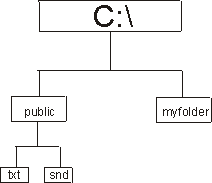 |
Basic Guide to
DOS
More about DOS |
Directory structure
The directory
structure in DOS is just like the one in Windows.
The drive C represents the root directory written
as C:\
nested directories are called Sub-directories.
Everything looks exactly like a tree except the
roots are at the top !!
 The directory that hosts subdirectories is called
Parent directory.
The directory that hosts subdirectories is called
Parent directory.
When listing directory content using DIR, (..)
refers to Parent directory
so if we're at C:\WINDOWS\Desktop> (.) refers
to Desktop and (..) refers
to WINDOWS. If you're wondering whether the dots
are useful, the answer is a straight YES.
The dots are used to navigate or explore the
directories.
Suppose you want to switch to WINDOWS directory
and apply the DIR command,
you can use the Change Directory command CD,
just type CD.. to go to WINDOWS directory.
For the complete listing of commands and usage go
to
Commands usage section.
The CD command is very useful when you want to
navigate in DOS.
To go back to Desktop type CD desktop.
If you follow the tree structure - with Root
directory C at the top -
typing cd.. while in Desktop will move you one
level up.
If you continue to type cd.. you will eventually
reach the top of the tree, the root directory.
If you type cd.. after you reach the root
directory you will get:
C:\>cd..
Invalid directory
|
|
 |
Choose a Tutorial
What do you need ?
|

